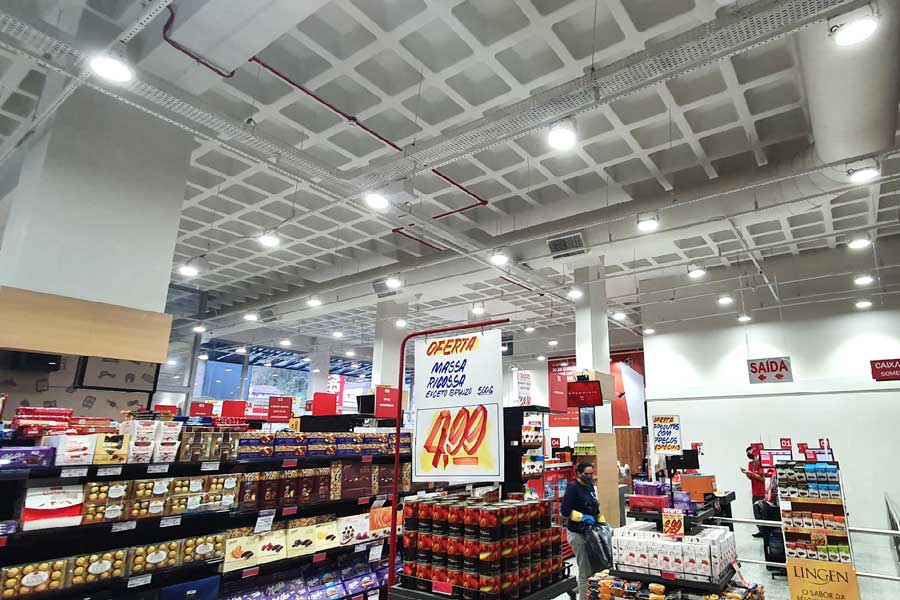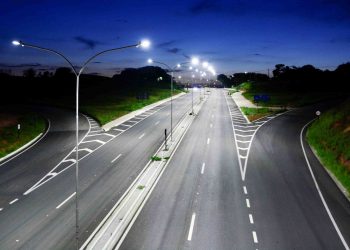
Check out how supermarket lighting should be done!
Supermarket lighting is mainly characterized by the sale of goods in the absence of vendors. Each shelf has a type of product, so that the customer feels comfortable and easily finds the items they want, lighting can be used as a powerful marketing tool.
Supermarket lighting needs to be planned through a project that presents an appropriate luminous flow and that contains a color index that makes the products more attractive to consumers. Thus, the environment will be welcoming and pleasant to audiences of all ages.
Want to know more about how supermarket lighting should be done? Keep reading!
What is a lighting project?
The lighting project, which is also known as a lighting design project, combines the aesthetic of the environment and functionality, and tends to yield good results for supermarket owners.
To carry out a project effectively, it is necessary to seek the help of professionals in the field who will analyze the location’s floor plan and use the correct luminaire installation specifications for each area of the place. This is essential so that the project can be applied correctly and pleasing to both the supermarket owner and customers.
Once the project is ready, it needs to be evaluated by the establishment’s owner. Their demands and needs must be taken into account since they are interested in improving the environmental conditions of their business and know perfectly well what points require more or less lighting.
Why is a project so important in supermarket lighting?
A lighting project is extremely important for the success of a supermarket, as it not only brings comfort to employees and customers but also offers sophistication to the place. Another relevant point is that visibility is essential to value the decoration, whether inside or outside the establishment.
The luminaires need to be suitable for each section of the supermarket, and certain points should be evaluated, such as:
- Harmonious luminaire design;
- Luminous distribution curve that provides an adequate level of lighting;
- Color temperature;
- Color rendering index that values the products and shelves;
- Correct power for low energy consumption;
- Adequate luminous flux so that the level of illumination meets current standards and values the sales floor.
Every lighting project of a commercial establishment goes through technical evaluations to comply with legal standards, as well as psychologists’ analysis, who help to think about how the customer feels when they are in front of a shelf.
The customer needs to feel excited because this will make them buy more. Other precautions must be taken so that the lighting is perfect. See our tips below!
Structure a lighting project with LED (Light Emitting Diode)
Investing in a lighting project with LED luminaires is an excellent option. This technology offers numerous benefits to supermarkets that use these alternatives in their environments. See what the main ones are:
- Reduction of costs both with energy and maintenance;
- Valorization of exposed products.
The correct LED luminaire makes the customer want to buy the product as soon as they set their eyes on it. Creating more colorful sections is a good strategy, as it highlights the shelves, drawing the attention of consumers to walk up to them and analyze the exposed products.
It is worth remembering that the appropriate level of illumination complies with standard NBR8995-1, created by ABNT (Brazilian Association of Technical Standards). It regulates lighting requirements for workplaces, such as:
- Retail sales areas;
- Offices;
- Dispatch and storage areas;
- Logistics center;
- Bakery areas.
The Regulatory Standard establishes the necessary level of visibility for each of the work environments and offers calculations to ensure the quality of the lighting design project. All of these areas must be adequately illuminated so that workers can perform their functions correctly and safely.
It is very important to note that lighting levels above the required standard can be used as long as the glare index is respected, but lower levels cannot be used.
Consider LED lighting with high color rendering index
Objects viewed under natural light appear different in color compared to those illuminated by artificial lights. Therefore, a color scale has been created and is called the Color Rendering Index (CRI). The higher the index, the closer the item will be to its natural color, which pleases the supermarket customer’s eye. Therefore, consider this option for lighting.
For supermarkets, the ideal CRI according to current regulations is above 80.
Invest in sensors and dimming to reduce consumption and increase return on investment
Investing in dimmable LED luminaires with natural light sensors is an excellent option. The combination of these two items enables automatic control of the light intensity, allowing for management of artificial lighting that is compensated by natural light.
An intelligent lighting system, i.e., with automation, can save up to 15% on energy costs. The brightness will be more intense at certain times and more subdued at others, resulting in energy savings. In areas such as restricted areas, bathrooms, and parking lots, energy can also be saved using motion sensors that turn on and off the lights when people enter or leave the premises. Motion sensors are ideal for storage areas in both stores and logistics centers.
Pay attention to the main spaces
Pay attention to the luminaires that can be used in each section of the supermarket. For shelves, invest in a specific type that highlights items. In corridors, opt for a set of lights that, combined with light-colored flooring, give customers the impression of a spacious environment.
Don’t forget to choose a prominent lighting system for the main areas of the market. Highlight a specific area of the establishment by placing specific lights in it. Among the areas that can be highlighted are the bakery, the fruit and vegetable section, and the meat department. To create a focus effect, use LED luminaires and reflectors.
You can unify the luminaire model for better future management and lower installation costs.
Consider using contrast in your project
While highlighting lighting emphasizes certain products, light beam patterns on walls, contrasts, and shadows can increase or decrease luminaire intensity, modifying perception in environments. Therefore, consider using contrast in your project.
Now that you have expanded your knowledge about lighting for supermarkets, use our tips to achieve the benefits mentioned in this article, including low maintenance costs, attractive environments, and reduced energy consumption expenses.
Don’t forget to choose specialized professionals to carry out your project and take advantage of all the benefits!
Now that you are convinced that SX Lighting will provide you with the best lighting, click here to request service from our specialists.
Share







